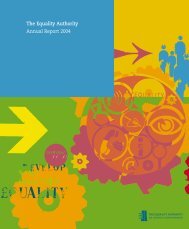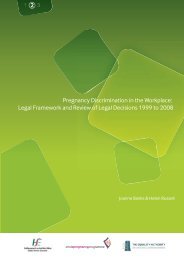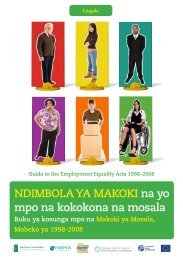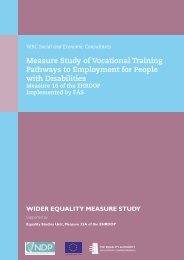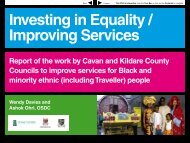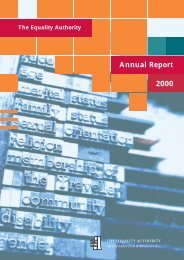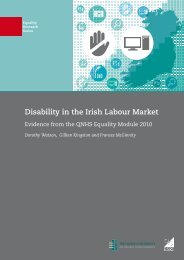Pregnancy and Employment: A Literature Review - Crisis Pregnancy ...
Pregnancy and Employment: A Literature Review - Crisis Pregnancy ...
Pregnancy and Employment: A Literature Review - Crisis Pregnancy ...
Create successful ePaper yourself
Turn your PDF publications into a flip-book with our unique Google optimized e-Paper software.
<strong>Pregnancy</strong> <strong>and</strong> <strong>Employment</strong>: A <strong>Literature</strong> <strong>Review</strong><br />
(Mahon et al, 1998). Interestingly, the authors report that in deciding to terminate a pregnancy the women were<br />
not rejecting motherhood per se, but motherhood under current circumstances, when they were financially<br />
unstable, beginning careers or in education (ibid). In recognition of the link between employment <strong>and</strong> pregnancy<br />
decision-making, pregnant employees are protected by EU directives which rule that the entire period of<br />
pregnancy <strong>and</strong> maternity leave is a special protected period <strong>and</strong> which prohibit pregnancy-related dismissal on<br />
grounds of equality. 18 This is in view of the harmful effects which the risk of dismissal may have on the physical <strong>and</strong><br />
mental state of pregnant women, including the particularly serious risk that they may be prompted voluntarily to<br />
terminate their pregnancy (Banks & Russell 2011).<br />
2.7 Employer’s Perspective<br />
Employers’ experiences of employing pregnant workers <strong>and</strong> their attitudes towards this group of employees have<br />
rarely been explored. As noted above, this lack of research may be due in part to an expectation that employers<br />
may give socially desirable responses to the researcher rather than reflect their actual views or behaviour.<br />
Nevertheless, the paucity of research on the employers’ perspective in Irel<strong>and</strong> means that an important element<br />
of the picture of pregnancy <strong>and</strong> workplace relations is missing. Research on employers in Irel<strong>and</strong> would add to our<br />
knowledge along three important dimensions:<br />
• Employers’ experiences of dealing with pregnancy in the workplace<br />
• Employers’ knowledge of <strong>and</strong> views about the regulations around pregnancy <strong>and</strong> maternity<br />
• Employers’ perspective on reintegrating women into employment following childbirth<br />
A recent study of 246 organisations in Irel<strong>and</strong> on attitudes to employment law was published by a private humanresource<br />
management firm, Graphite. This study did not provide any information on the sample selection<br />
<strong>and</strong> the methodology <strong>and</strong> as a result the findings cannot be viewed as representative. Moreover, some of the<br />
questions appear to be leading <strong>and</strong> some of the response scales reported are unbalanced, which undermines<br />
the validity of the results. The majority of organisations surveyed were in the private sector (87%) <strong>and</strong> with<br />
regard to organisational size, 22% had fewer than 20 employees, 35% had 21 to 100 employees, 25% had 101<br />
to 500 employees <strong>and</strong> 17% had over 500 employees. In response to the question “do you believe that current<br />
provisions for maternity leave are too generous?”, 39% of respondents said yes (Graphite, 2009, p.19). Almost 59%<br />
of employers believed that the length of maternity leave affects women’s promotional or career opportunities,<br />
but only 13% said that maternity leave provisions affected their decision when hiring women of child-bearing age.<br />
The authors suggest that these two responses do not ‘stack up’ <strong>and</strong> acknowledge that there may be a socialdesirability<br />
bias in the responses on hiring (ibid, p20).<br />
As part of the EOC programme of research in the UK, in 2004 a survey of employers was carried out, which<br />
was specifically designed to examine employer’s awareness of legal rights <strong>and</strong> responsibilities with respect to<br />
pregnancy at work <strong>and</strong> to investigate the reasons for non-compliance (Young & Morrell, 2005a, 2005b, 2005c).<br />
This research involved a survey of over 800 employers 19 across Britain: 453 in Engl<strong>and</strong>, 150 in Wales <strong>and</strong> 205<br />
in Scotl<strong>and</strong>. The sample was stratified by broad workplace size <strong>and</strong> sector, <strong>and</strong> the results were re-weighted to<br />
reflect the distribution of businesses by size <strong>and</strong> sector within each country. Organisations with fewer than five<br />
employees were excluded from the survey.<br />
The authors suggest that the unfavourable treatment of pregnant women by employers arises partly from a lack of<br />
knowledge about their responsibilities <strong>and</strong> the entitlements of pregnant women, partly from negative perceptions<br />
about pregnant women or mothers of young children in the workplace, <strong>and</strong> partly due to negative attitudes about<br />
employment regulations.<br />
While the majority of employers said they were supportive of employees when they were pregnant <strong>and</strong> on their<br />
return to work, a significant minority expressed negative views, which could account for the minority of employers<br />
who treat these women unfavourably. For example, in the survey of English employers (Young & Morrell, 2005a):<br />
18 Equal Treatment Directive (76/207/EEC) <strong>and</strong> the <strong>Pregnancy</strong> Directive (92/85/EEC)<br />
19 The survey was administered to human-resource managers or equivalent <strong>and</strong> was carried out by telephone. Organisations were approached at<br />
establishment level, i.e. not at head office, where there was more than one outlet.<br />
PAGE 21




